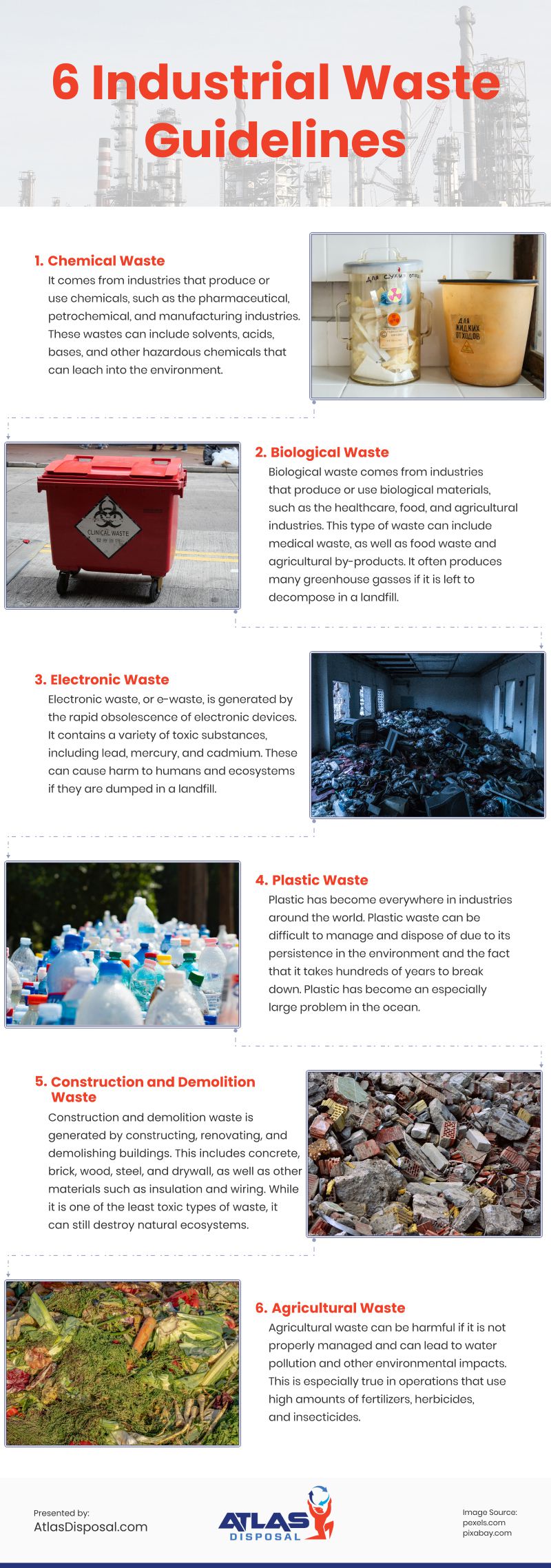A Simple Guide to Industrial Waste
Every industry produces some type of waste. Waste that results from industrial activities, such as manufacturing, mining, or milling is called industrial waste. Industrial waste is specific to the industry it comes from and often needs to be processed separately from general public waste collection.
Industrial waste can significantly impact the environment and public health if it is not properly managed and disposed of. Here are some common types of industrial waste and how they can be harmful:
Chemical Waste:
Chemical waste is generated by industries that produce or use chemicals, such as the pharmaceutical, petrochemical, and manufacturing industries. These wastes can include solvents, acids, bases, and other hazardous chemicals that can be toxic to aquatic life, leach into soils, and corrode metals.
Biological Waste:
Biological waste comes from industries that produce or use biological materials, such as the healthcare, food, and agricultural industries. This type of waste can include medical waste, such as sharps and needles, as well as food waste and agricultural by-products. Biological waste often produces many greenhouse gasses if it is left to decompose in a landfill.
Electronic Waste:
Electronic waste, or e-waste, is generated by the rapid obsolescence of electronic devices, such as computers, smartphones, and televisions. E-waste contains a variety of toxic substances, including lead, mercury, and cadmium. While these are valuable elements, they can also cause harm to humans and ecosystems if they are dumped in a landfill.
Plastic Waste:
Plastic waste is one we’re all familiar with on a consumer scale. Plastic has become everywhere in industries around the world. Plastic waste can be difficult to manage and dispose of due to its persistence in the environment and the fact that it takes hundreds of years to break down. Plastic has become an especially large problem in the ocean, with the formation of the Great Pacific Garbage Patch north of Hawaii.
Construction and Demolition Waste:
Construction and demolition waste is generated by constructing, renovating, and demolishing buildings and infrastructure. This type of waste includes concrete, brick, wood, steel, and drywall, as well as other materials such as insulation and wiring. While it is one of the least toxic types of waste, it can still destroy natural ecosystems, run off into waterways, and attract pests.
Agricultural Waste:
Agricultural waste is generated by the production of food, feed, and fiber. Materials such as animal manure, crop residues, and sprays. Agricultural waste can be harmful if it is not properly managed and can lead to water pollution and other environmental impacts. This is especially true in operations that use high amounts of fertilizers, herbicides, and insecticides.
Proper management and disposal of industrial waste is essential to protect the environment and public health.
So what do we do about it?
In many cases, industrial waste can be recycled or reused, which can help to reduce the amount of waste that is sent to landfills and incinerators.
There are also a variety of technologies and techniques that can be used to treat and manage industrial waste, including incineration, landfilling, and composting. Figuring out which of these strategies is best for your industry can be difficult. That’s where waste management companies like Atlas Disposal can fill the knowledge gap and point you in the best direction.
Case in Point
Imagine a business in the industry of apartment construction. Let’s call them Highrise Builders. Imagine they have just started work on a new building in Salt Lake City. Before they can put down the foundation, they have to demolish an old and unused warehouse. They have some capacity for disposing of the debris in their own dumpsters. However, since they usually only deal with industrial construction waste and not demolition, their dumpsters are soon overflowing.
The manager searches the web for “dumpster rental Salt Lake City, Utah.” The search returns a waste disposal company with a large assortment of rental dumpsters available. The waste disposal company arrives that same afternoon with three more construction dumpsters for the project. By the next day, the demolition waste is completely cleared, and construction can begin.
This is a classic example of how industrial waste can and should be dealt with. Search in your local area, and there will be local assistance and expertise on getting rid of junk. Even if you have the capacity for your waste, checking your process with a waste disposal company can often save time and money.
Final Note
It is important to note that the most effective way to manage industrial waste is to prevent it from being generated in the first place. Implementing effective waste reduction strategies, such as the use of environmentally friendly products and processes can help.
It is crucial for industries to be aware of the types of waste they generate and to take steps to properly manage and dispose of it in order to protect the environment and public health.
Infographic
In every sector, garbage gets generated. The residual material of industrial activities like manufacturing, mining, or milling is known as industrial waste. If industrial waste is not handled and disposed of appropriately, it might significantly harm the environment and the general people. Here are some mainstream types of industrial waste and their potential level of danger.

Video

